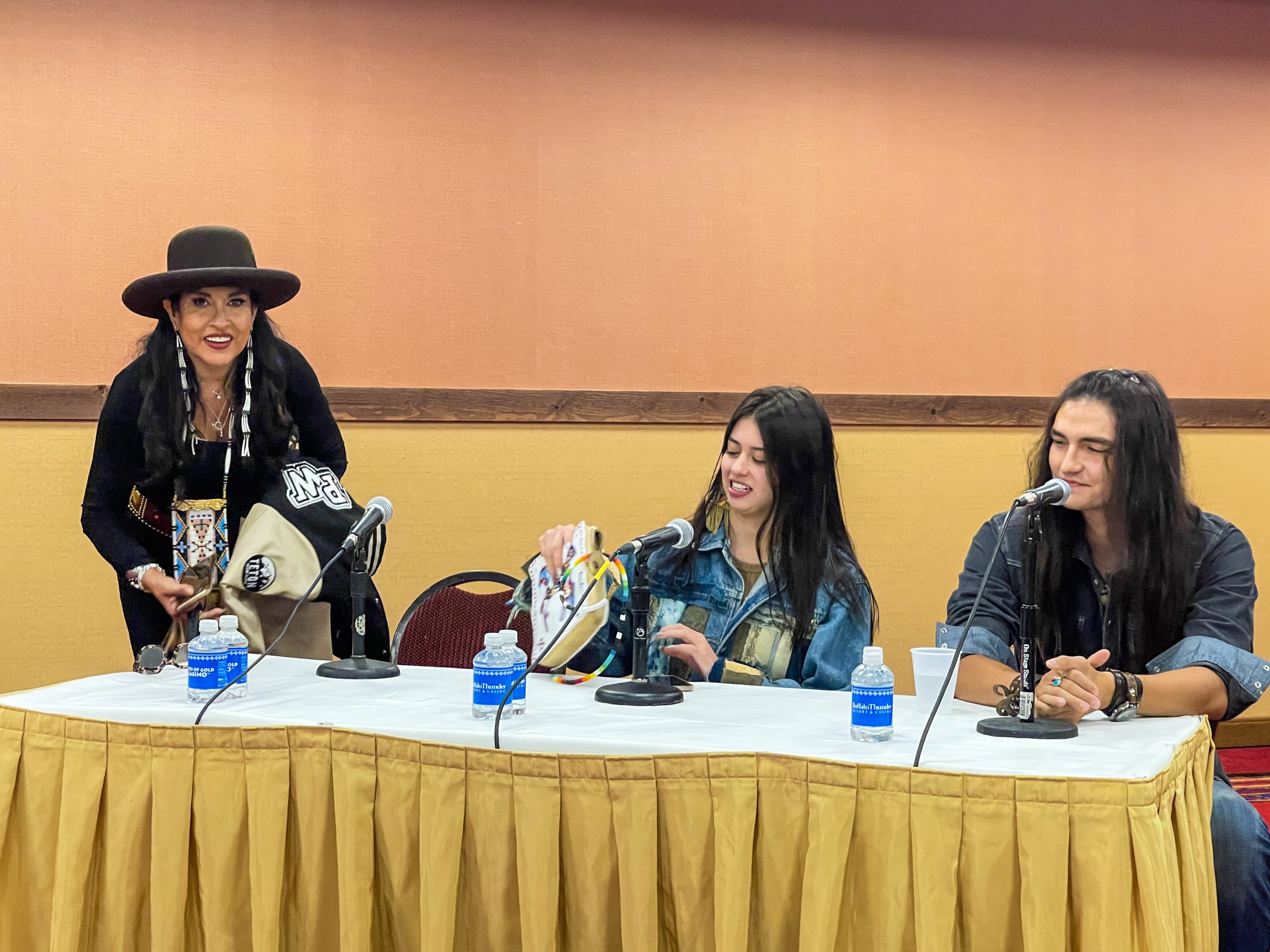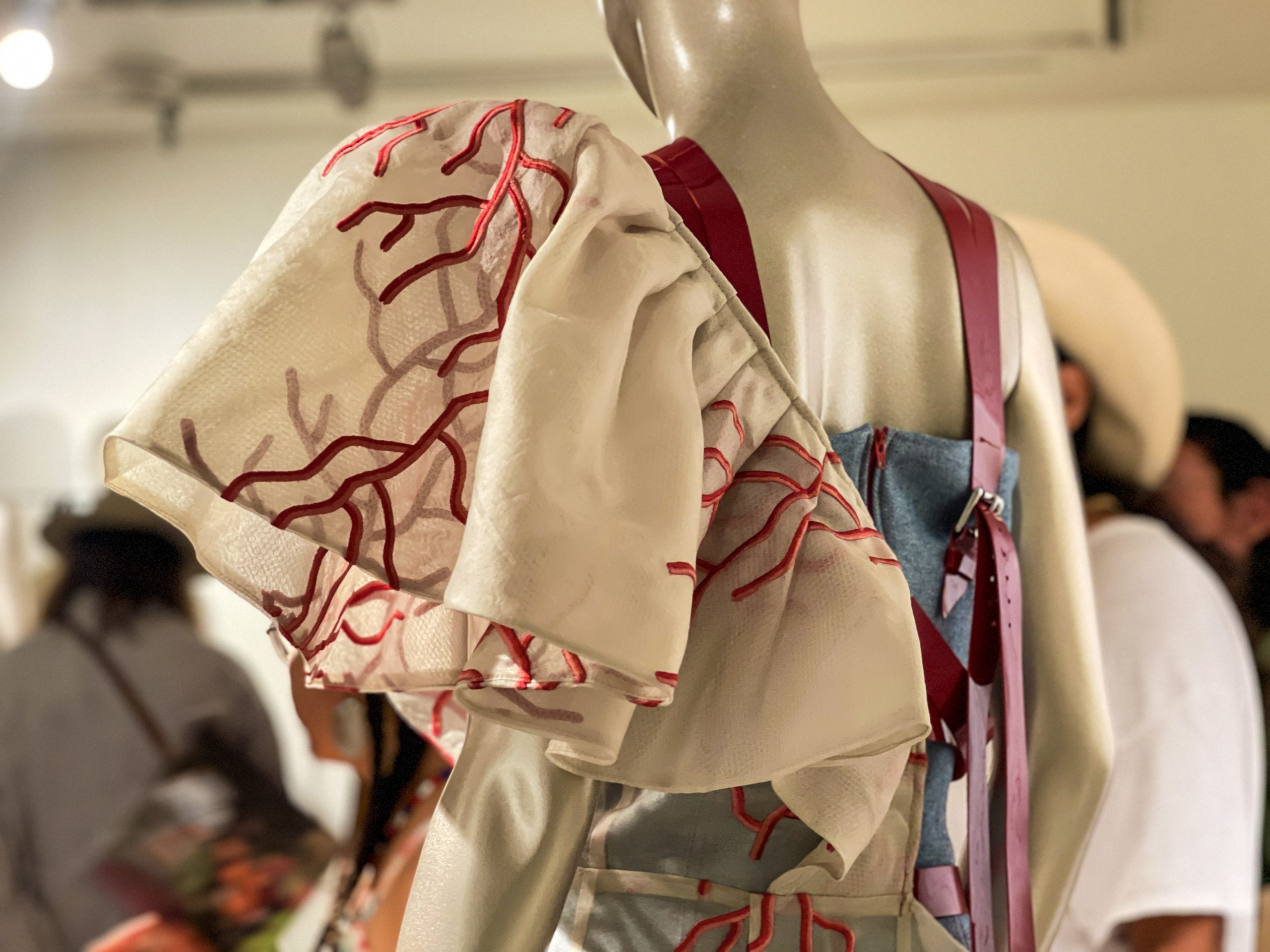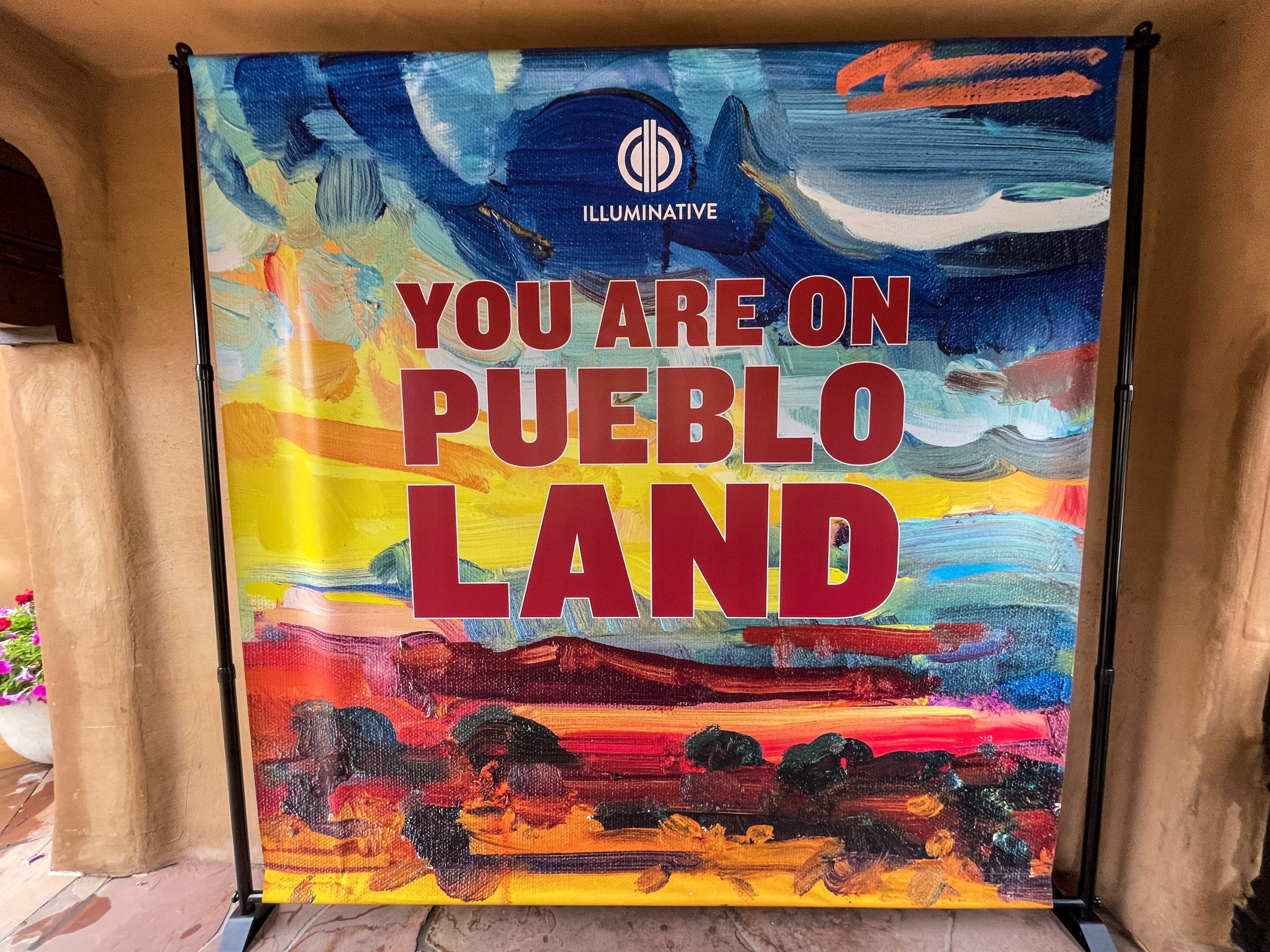Indianz.Com > News > ‘Who is your family?’: Big backers of breakout hit Prey falter on tribal affiliation inquiry
‘Who is your family?’
Big backers of breakout hit Prey falter on tribal affiliation inquiry
Monday, September 12, 2022
Indianz.Com
POSUWAGEH, New Mexico — “Who is your family?” the Pueblo woman asks.
It’s a common question, one posed all the time across Indian Country. The answer helps people — especially those from the same tribal community — learn of their shared connections.
And being asked here, on the homelands of the Pueblo of Pojoaque, whose Tewa language name of Posuwageh can be translated as Water Drinking Place, the inquiry takes on added significance. The person asking, and the person answering, are supposed to be from the same tribal nation.
“Who is your family?”
For Dakota Beavers, hailed by one Native media site as the “breakout star” of the wildly popular Prey action film streaming on Hulu, the question is a relatively new one. Up until a couple of months ago, he was a virtual unknown, with his appearance in the Predator franchise representing his debut on the screen. And up until his participation in the project became known, Beavers had never publicly claimed an affiliation with Ohkay Owingeh, another Tewa language speaking Pueblo about 20 minutes up the road from Pojoaque. Along with his father and brother, he’s been trying to find artistic success in an entirely different kind of country — one more than 1,200 miles away in fact. But in responding to the inquiry, Beavers has come to the homelands of the Pueblo people prepared. Having been led into the ways of Indian Country by Jhane Myers, the much lauded producer of Prey, he has an easy answer for the question posed at the Water Drinking Place. “My grandmother is Josephine Archuleta,” Beavers says in a hallway at the Buffalo Thunder Resort.

‘We just want, like, something to be right’
Not long before her young star is asked about his family, Jhane Myers is fielding a whole different set of questions at another Pueblo place with a Tewa language name. The producer is participating in a panel discussion hosted by Illuminative during a “first-ever VIP event” that the Native-led social justice organization brought to Ogapogeh, the city more commonly known as Santa Fe.
Myers, who hails from the Comanche Nation and has ties to the Blackfeet Nation, won praise for infusing her Indian Country knowledge into “every frame of this film.” She accepted the accolade from the moderator of the panel and said she was guided by one major principle: to ensure Prey represented Native people authentically.
“Every time I see a project, when it’s like in the 1700s, I’m kind of like, ‘Oh no,'” Myers said at a VIP tent pitched on a balcony at La Fonda on the Plaza, a historic luxury hotel in Ogapogeh, whose Tewa name can be translated as White Shell Water Place.
“You know, because we just want, like, something to be right,” Myers said of her efforts to make sure Prey didn’t repeat the mistakes of the past when it comes to inaccurate portrayals, depictions and representations of Native people.

Prey is set on the Comanche Nation in the 1700s — 1719, to be exact. From the clothing and the use of the Comanche language all the way to the cast and crew, Myers said she took her role as a producer — more specifically, as a Native producer — seriously. “I was like, ‘Oh, we’re gonna do this different,'” Myers told the audience at Illuminative’s “Indigenous Futures: Envisioning the Next 100 Years” event, which cost $150 a day to attend, or $250 for two days. “Any time that Native people can hire other Native people and you’re in a position … as a producer, that’s when you address it,” Myers added. “When we’re not producers, when we’re something else, that’s why things don’t get addressed,” she continued, again explaining her insistence on forging a new path for Native people on screen. “But if you’re at the table — and I’m pushy, I guess — you know, you can just say, ‘Hey, wait a minute. That’s not right,'” Myers concluded.
‘Another one of those mixed Southwestern kids’
In the production notes for Prey, Dakota Beavers is described as a “newcomer” to film and a “descendant of Ohkay Owingeh Pueblo.” But that’s not the only tribal affiliation this young actor, whose long hair hangs well past his shoulders, is asserting.
Mainstream media coverage of Beavers repeatedly make mention of a general “Apache” heritage. None of the outlets, however, reported which specific tribal nation the Prey star supposedly hails from. New Mexico alone is home to three federally-recognized Apache tribes, with several more based in the neighboring states of Arizona and Oklahoma.
Instead, the tribal affiliations claimed by Beavers were simply passed along as gospel from the powers that be. Prey has the backing of 20th Century Studios, one of the oldest and largest film production studios in Hollywood, which itself was acquired by Disney, the media and entertainment behemoth, in a deal worth more than $71 billion.
It wasn’t until an interview with Native America Calling, a Native-owned outlet renowned for its Studio 49 in Albuquerque, New Mexico, that Beavers offered specifics. He not only reassured show host Shawn Spruce of his supposed ties to Ohkay Owingeh, he revealed the origins of his “Apache” heritage for the first time in public.
“I’m a descendant of Ohkay Owingeh Pueblo on my mother’s side,” Beavers said an interview from the home his family is renting in Ogapogeh. “I’ve also got Apache on my mother’s side — Mescalero Apache — and a couple of other things.”
“I’m like another one of those mixed Southwestern kids,” he noted, adding that being in New Mexico, home to so many tribes and their people, feels different than Tennessee. Elsewhere in the interview, he tells Spruce that he grew up in Arizona, where nearly two dozen tribes are based.

‘Don’t tell anybody I told you this’
At one point, Prey had someone handling “Native Community Engagement” for Walt Disney Studios and 20th Century Studios in advance of the film’s August 5 debut on Hulu. The position, which was held by a Native person, represented another way in which the project was “different” than prior Hollywood productions.
By all accounts, the initiative has paid off. According to Jhane Myers,
Prey has shattered records at Hulu, whose majority owner is Disney. During a public question and answer session last month at Posuwageh, where she traveled following her engagement at Illuminative, she shared what she said was insider knowledge about the success of the groundbreaking production.
“This is the largest launch that Hulu has ever had,” Myers told attendees of the Pathways Indigenous Arts Festival that was hosted by the Pueblo of Pojoaque on the tribe’s reservation north of Santa Fe.
“I can probably tell you this, but don’t tell anybody I told you this,” she said before explaining that studio officials projected that 31 million people worldwide would watch Prey during the first 10 weeks of its release.
“That’s the projection, right?” Myers said during the session on August 20. “I had a meeting last week. Out of 10 days, 33.1 million had watched this.”
“We didn’t expect that because we wanted to, like I said, make a movie for you,” Myers said, referring back to her principle that she helped create Prey in order for Native audiences to appreciate it.
“I wanted this film to be for Native people and it doesn’t matter who all likes it — but everyone likes it,” Myers also told the crowd at Pathways. “But it was for all of you first.”
‘We’ll have to politely pass’
Despite the dedication that audiences across Indian Country have shown to Prey, the giant that is Disney has not been as willing to return the attention — especially when it comes to wanting like, something, to be right about its talent and their claimed tribal affiliations.
After all, Ohkay Owingeh, as well as the Mescalero Apache Tribe, are just a time zone, a phone call and an email away from Hollywood. Both tribal nations offer contact information on their publicly accessible websites.
And in the case of Ohkay, the tribe is only about 30 miles north of New Mexico’s capital city, which just celebrated the centennial Santa Fe Indian Market, a busy weekend of art, fashion, film and television, all created by Native people themselves.
But up until Pueblo people started asking questions about a week before the Pathways Indigenous Arts Festival at Posuwageh and the Illuminative VIP event in Ogapogeh, no one from Prey had ever spoken to anyone from Ohkay Owingeh about Dakota Beavers and his claim of being a “descendant” of the tribe.
And when given an opportunity to explain whether Disney had taken any steps to contact Ohkay Owingeh and the Mescalero Apache Tribe to ensure the sovereign nations were at the very least aware of the worldwide production, the “team leading all multicultural efforts” at the studio — three people, to be exact — decided the inquiry wasn’t significant enough to answer.
“At this time based on talent availabilities we’ll have to politely pass,” the three-person team at Disney told Indianz.Com. Producer Jhane Myers did not respond to the request for details either, merely passing along the inquiry about Beavers to Disney.

‘That’s just what I was told’
When it comes to affiliation, the decision of who belongs rests with a sovereign tribal nation. In some instances, such determinations can be controversial, especially if blood quantum, ancestral connection or other factors come into play.
But in the hallway at the Buffalo Thunder Resort, the young star of Prey reveals that his tribal affiliation rests on something entirely different. As he awaits the arrival of producer Jhane Myers for their question and answer session at Posuwageh, Dakota Beavers tells Indianz.Com that one of his claims is based on family lore.
Why did he say he was Mescalero Apache on Native America Calling?
“That’s just what I was told,” Beavers responded.
As for his claim of being from Ohkay Owingeh, Beavers admits he’s a newcomer. For example, he isn’t aware that “descendant” isn’t a category used by the tribe when it comes to determining who belongs.
“I didn’t know that,” Beavers replies.
What Beavers does know is that he just recently made the 30-mile drive from Ogapogeh to Ohkay Owingeh for the first time since he started publicly claiming to be a “descendant” of the tribe. He dropped off an application for enrollment only days before the start of the busy weekend of Indian arts and culture in northern New Mexico. And well before his short trip through Pueblo country, Beavers was already identifying himself as belonging to a specific tribal community. Not only did he take part in the Prey session at Pathways Indigenous Arts Festival on August 20, his family’s WesternBoy band took the stage at the event the following day, having responded to the event’s open call for performers. Based on information Beavers and his family provided through the open call, Pathways even labeled WesternBoy as “Ohkay Owingeh Descendant.” No other performer was described in such a manner — everyone else was identified by their specific tribe or tribal nations for those who are affiliated with their communities.
‘Native American blood in my DNA’
What Beavers also knows is his DNA. In an email to Indianz.Com, he makes a connection between what a commercial genetic testing company told him and what his family told him.
“I do know for a fact that that I have Native American blood in my DNA, and I had been told all my life that I was Apache,” Beavers says in the days following his debut appearance in Pueblo country.
By this time, Beavers already knows, or should already know, that his application for enrollment at Ohkay Owingeh has been rejected. A letter was sent to the house his family is renting in Ogapogeh, only a week after he made the drive and requested review of his documentation by a sovereign tribal government.
In the letter, dated August 22, Beavers was informed that the “family ancestry” he submitted bears no connection whatsoever to Ohkay Owingeh. As a result, he is “ineligible” for tribal enrollment.

There are even Archuleta families at Ohkay Owingeh. But his maternal grandmother, whose family left southern New Mexico in the early 1900s, does not have a connection to any of them, as the tribe’s letter to Beavers indicates. His grandmother was born and raised in Arizona, where she continues to reside under her married surname. In spite of the determination already made by a sovereign tribal government, Beavers believes that he needs additional information to show that his research is wrong. Once he receives such confirmation, he promises: “I absolutely will not represent myself as Ohkay Owingeh.” As for his claim of being from the Mescalero Apache Tribe, Beavers does not appear willing to make a similar pledge. He again turns back to what he’s been told of his genetic makeup. “I will continue to search for the source of my indigenous DNA,” Beavers tells Indianz.Com., adding that “finding the truth is very important to me.”
The Dakota Beavers saga doesn’t end here folks. A forthcoming post on Pretendian Country Today will reveal where the Prey star went wrong with his research. And we’ll gain some insight into how one Native outlet asks about tribal affiliation. So join Indianz.Com at Pretendian Country Today! Similarly, the Dakota Beavers story is just the beginning when it comes institutions and organizations, big and small, faltering in their approach to tribal affiliations. Whether it’s a non-profit serving Indigenous peoples or the group trying to recover from a shocking slap seen around the world, stay tuned to Indianz.Com for more.
Related Stories
Search
Filed Under
Tags
More Headlines
Native America Calling: How Native literature is changing the mainstream narrative
Native America Calling: No ordinary animal
Native America Calling: Safeguards on Artificial Intelligence
NAFOA: 5 Things You Need to Know this Week
Chuck Hoskin: Cherokee Nation takes the lead for our environment
Native America Calling: Earth Day assessment for Native peoples
Cronkite News: Gathering addresses ‘epidemic’ among Native people
VIDEO: Cody Desautel on tribes and federal forest management
AUDIO: Legislative Hearing on Discussion Draft of Forest Management Bill
Native America Calling: Remembering the 1974 Navajo border town murders
Native America Calling: Can the right approach close the Native immunization gap?
Cronkite News: Long COVID cases remain high in Arizona
Native America Calling: Eyes in the sky for development, public safety, and recreation
Native America Calling: Three new films offer diverse views of Native life
NAFOA: 5 Things You Need to Know this Week
More Headlines
Native America Calling: No ordinary animal
Native America Calling: Safeguards on Artificial Intelligence
NAFOA: 5 Things You Need to Know this Week
Chuck Hoskin: Cherokee Nation takes the lead for our environment
Native America Calling: Earth Day assessment for Native peoples
Cronkite News: Gathering addresses ‘epidemic’ among Native people
VIDEO: Cody Desautel on tribes and federal forest management
AUDIO: Legislative Hearing on Discussion Draft of Forest Management Bill
Native America Calling: Remembering the 1974 Navajo border town murders
Native America Calling: Can the right approach close the Native immunization gap?
Cronkite News: Long COVID cases remain high in Arizona
Native America Calling: Eyes in the sky for development, public safety, and recreation
Native America Calling: Three new films offer diverse views of Native life
NAFOA: 5 Things You Need to Know this Week
More Headlines
